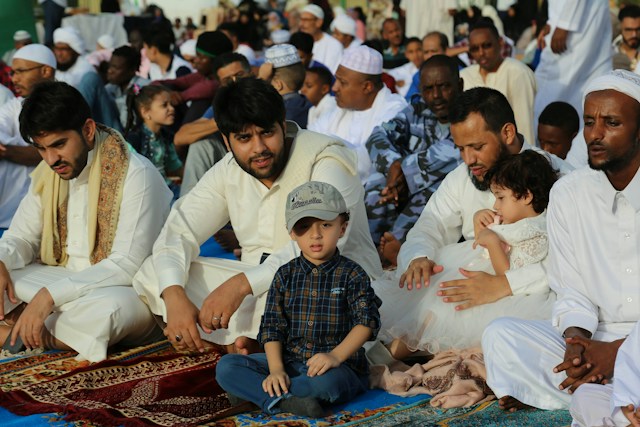Ayodhya’s Muslims: Ayodhya, a town predominantly Hindu, is buzzing with anticipation as the inauguration of the new multimillion-dollar Ram Janmabhoomi Mandir approaches. Indian Prime Minister Narendra Modi is set to officiate the event, marked by the fluttering of saffron flags and a fervor among the locals. However, as the town braces for the grand ceremony, a palpable unease grips its Muslim community of 500,000 residents.
The Shadow of the Past: Babri Mosque’s Demolition
For 65-year-old Maulana Badshah Khan and many others, memories of religious violence from over three decades ago loom large. The destruction of the Babri Masjid in 1992 by Hindu nationalists ignited riots across India. Khan, expressing his apprehension, chooses to stay at home during the temple’s inauguration, fearing a repetition of past events.
A Monument to Hindu Nationalist Ambition
On Monday, Modi will officially unveil the Ram Janmabhoomi Mandir, perceived by analysts as a symbol of Hindu nationalist ambition. Khan believes this celebration signifies the marginalization of Muslims under Modi’s Bharatiya Janata Party (BJP), stating, “The temple holds the symbolic value of showing the Muslims their place in New India.”
Fear and Anxiety Among Ayodhya’s Muslims
As more than 7,000 people, including high-profile politicians, gather in Ayodhya for the ceremony, anxiety brews among the town’s Muslims. Azam Qadri, the head of a local religious body, voices concerns about potential trouble when outsiders arrive, referencing the 1992 violence. Haji Mahboob, who lost relatives in that unrest, expresses worry about provocative slogans and a sense of hopelessness within the Muslim community.
The Rise of Hindu Nationalism Under Modi
Nalin Kohli, BJP spokesperson, denies claims of Muslim marginalization, insisting that the Ram Mandir’s inauguration is a “cause for celebration.” However, critics argue that Modi’s push for a Hindutva agenda has led to discriminatory legislation and increased tensions, with the construction of the temple seen as a move toward Hindu hegemony.
The New Mosque: Distant Hopes and Delays
While the 2019 Supreme Court judgment allowed the construction of the Ram Mandir, it also allocated land for Ayodhya’s Muslims to build a new mosque in Dhannipur. However, delays in construction and the distant location leave many Muslims feeling emotionally disconnected. Arafat Shaikh, appointed to lead the mosque’s construction, aims for a unique design, incorporating five minarets and ambitious plans for additional facilities.
Enduring Divisions and Hope for Reconciliation
For more Informative content and latest news : NRUTime
The inauguration of the Ram Temple is hailed by Hindu nationalist groups as a symbol of a new Hindu nation. However, voices like Mahant Jairam Das argue against building the mosque in Ayodhya, seeing it as a potential source of conflict. The town’s inhabitants, scarred by past violence, grapple with enduring divisions and a sense of uncertainty about the future.
conclusion:
As Ayodhya prepares for the monumental event, the contrasting emotions of celebration and apprehension underline the complex dynamics shaping the town’s social fabric. The inauguration may symbolize a milestone for some, but for others, it rekindles painful memories and accentuates existing divisions.
FAQS:
What is the significance of the Ram Janmabhoomi Mandir inauguration in Ayodhya?
- The inauguration marks the official unveiling of the Ram Janmabhoomi Mandir in Ayodhya, a multimillion-dollar project set to be officiated by Indian Prime Minister Narendra Modi. The event is seen as a symbol of Hindu nationalist ambition, with the construction of the temple viewed by some as a milestone for the Hindu community.
How does the past demolition of the Babri Masjid impact the Muslim community’s sentiments in Ayodhya?
- The demolition of the Babri Masjid in 1992, a traumatic event for many, casts a shadow over Ayodhya’s Muslim community. Memories of religious violence have led to apprehension among some residents, such as Maulana Badshah Khan, who fears a repetition of past events and chooses to stay home during the temple’s inauguration.
What concerns and anxieties do Ayodhya’s Muslims express regarding the Ram Janmabhoomi Mandir inauguration?
- Ayodhya’s Muslim residents, numbering around 500,000, expressed fears of potential trouble during the temple’s inauguration. Concerns include the possibility of outsiders causing disturbances, reference to the 1992 violence, worries about provocative slogans, and a sense of hopelessness within the Muslim community.
How do proponents and critics view the inauguration of the Ram Janmabhoomi Mandir in terms of religious and political implications?
- Proponents, like Nalin Kohli, a spokesperson for the Bharatiya Janata Party (BJP), view the temple’s inauguration as a cause for celebration, denying claims of Muslim marginalization. Critics argue that Prime Minister Modi’s push for a Hindutva agenda has led to discriminatory legislation and increased tensions, perceiving the temple construction as a move toward Hindu hegemony.
What is the status of the proposed new mosque for Ayodhya’s Muslims, and what challenges do they face in its construction?
- The 2019 Supreme Court judgment not only allowed the construction of the Ram Mandir but also allocated land for Ayodhya’s Muslims to build a new mosque in Dhannipur. However, delays in construction and the distant location have left many Muslims feeling emotionally disconnected. Arafat Shaikh, appointed to lead the mosque’s construction, aims for a unique design but faces challenges in materializing the plans.
How do Hindu nationalist groups perceive the inauguration of the Ram Temple, and what opposing views exist within Ayodhya?
- Hindu nationalist groups hail the inauguration as a symbol of a new Hindu nation. However, voices like Mahant Jairam Das argue against building the mosque in Ayodhya, seeing it as a potential source of conflict. The town’s inhabitants, scarred by past violence, grapple with enduring divisions and uncertainty about the future.
What efforts, if any, are being made towards reconciliation and addressing the divisions in Ayodhya’s social fabric?
- Ayodhya’s social fabric is marked by contrasting emotions of celebration and apprehension. While the inauguration symbolizes a milestone for some, others continue to grapple with enduring divisions. Efforts towards reconciliation include the Supreme Court’s allocation of land for a new mosque and the appointed leader, Arafat Shaikh’s, ambitious plans for its construction. However, the complex dynamics and scars of past violence present ongoing challenges for fostering unity


